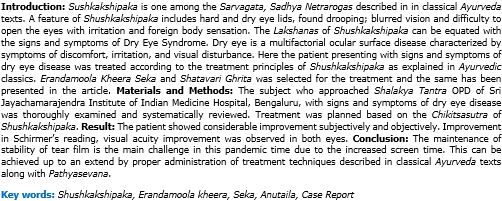An Ayurvedic approach to the management of Shushkakshipaka w.s.r. to Dry Eye Syndrome - A Case Report
Keywords:
Shushkakshipaka, Erandamoola kheera, Seka, Anutaila, Case ReportAbstract
Introduction: Sushkakshipaka is one among the Sarvagata, Sadhya Netrarogas described in in classical Ayurveda texts. A feature of Shushkakshipaka includes hard and dry eye lids, found drooping; blurred vision and difficulty to open the eyes with irritation and foreign body sensation. The Lakshanas of Shushkakshipaka can be equated with the signs and symptoms of Dry Eye Syndrome. Dry eye is a multifactorial ocular surface disease characterized by symptoms of discomfort, irritation, and visual disturbance. Here the patient presenting with signs and symptoms of dry eye disease was treated according to the treatment principles of Shushkakshipaka as explained in Ayurvedic classics. Erandamoola Kheera Seka and Shatavari Ghrita was selected for the treatment and the same has been presented in the article. Materials and Methods: The subject who approached Shalakya Tantra OPD of Sri Jayachamarajendra Institute of Indian Medicine Hospital, Bengaluru, with signs and symptoms of dry eye disease was thoroughly examined and systematically reviewed. Treatment was planned based on the Chikitsasutra of Shushkakshipaka. Result: The patient showed considerable improvement subjectively and objectively. Improvement in Schirmer’s reading, visual acuity improvement was observed in both eyes. Conclusion: The maintenance of stability of tear film is the main challenge in this pandemic time due to the increased screen time. This can be achieved up to an extend by proper administration of treatment techniques described in classical Ayurveda texts along with Pathyasevana.
Downloads
References
Kaviraj Ambikadatta Shastri. Susrutha samhita of Maharshi Susrutha edited with Ayurveda Tattva Sandipika hindi commentary, scientific analysis notes. Reprint-edition 2015.Varanasi: Choukambha Orientalia; part 2 (uttara tantra), p.39.
Prof.K.R.Srikantha Murthy, Vagbhata’s Ashtanga Hrdayam, Vol.III, Chaukamba Krishnadas Academy, Varanasi, Reprint-sixth edition,2015.p140
Tripathi Shri Indradeva, Gadanigraha, Vol.III edited Pandey Sri Ganga sahaya Chaukhambha Sanskrit Sanshthan, 2011.p98
Prof.D.Shanth Kumar Lucas, Dravyaguna Vijnana, Vol.II, Chaukhamba Vishwabharati, Varanasi, Reprint-2012,p387
Alok, S., Jain, S. K., Verma, A., Kumar, M., Mahor, A., & Sabharwal, M. (2013). Plant profile, phytochemistry and pharmacology of Asparagus racemosus (Shatavari): A review. Asian Pacific Journal of Tropical Disease, 3(3), 242–251. https://doi.org/10.1016/S2222-1808(13)60049-3















